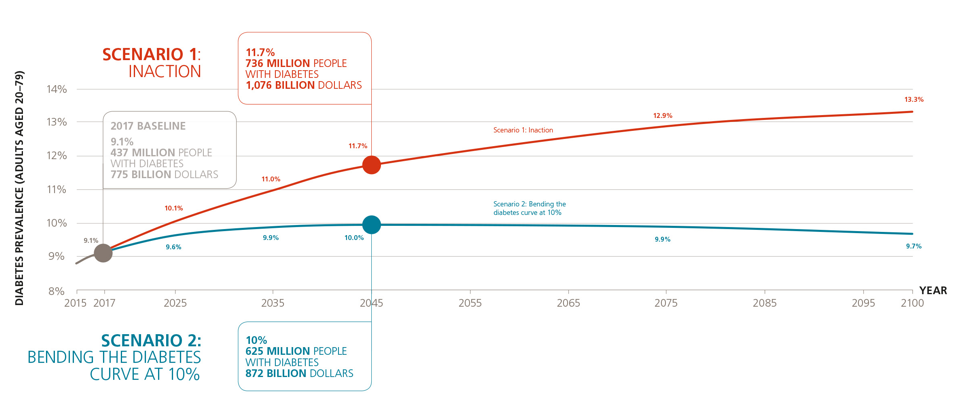
23rd May 2018 Obesity prevalence will rise from 14% to 22% by 2045 On current trends, nearly a quarter of people in the world will be obese and one in eight will have type 2 diabetes by mid-century, according to research by the European Association for the Study of Obesity.
New research presented at the European Congress on Obesity in Vienna, Austria, (23-26 May) demonstrates that if current trends continue, nearly a quarter (22%) of the global population will be obese by 2045 (up from 14% today). One in eight (almost 12%) will have type 2 diabetes (up from 9% now). The study, by Danish and UK researchers, also indicates that to prevent the prevalence of type 2 diabetes from going above 10% in 2045, global obesity levels must be reduced by 25%. Population data was obtained from the Non-communicable Disease Risk Factor Collaboration (a WHO database). For each country, the population was divided into age groups. From 2000-2014 (chosen because data is most reliable from 2000 onwards), the population in each age group was divided into body mass index (BMI) categories. For each country and age group, the share of people in each BMI class was projected. The diabetes risk for each age and BMI group was then applied to allow estimations of diabetes prevalence for each country each year. The prevalence for each country was calibrated to match the International Diabetes Federation's regional estimates, thereby taking into account differences in way of life, nutrition and genetic disposition. The startling projections suggest that, based on current trends, massive strain could be placed on health systems around the world, which are already spending huge sums just to treat diabetes. Although immediate action will not result in reversing the epidemic quickly, it is essential to begin work now to prevent new cases of obesity and diabetes, the study authors say. Their model indicates that, in order to stabilise diabetes prevalence at 10% (as shown in the graph below), obesity prevalence must fall steadily and in total by around a quarter – from the current level of 14% to just over 10% by 2045.
The authors note that the above numbers are for the 'global' scenario. Individual countries display individual trends and should be given their own targets. If the current trends in the USA continue, for example, obesity will increase from 39% to 55% by 2045, and diabetes rates from 14% to 18%. To keep diabetes rates in the USA stable between 2018 and 2045, obesity must fall to 28%. And in the United Kingdom, current trends predict that obesity will rise from 32% today to 48% in 2045, while diabetes will rise from 10.2% to 12.6%, a 28% rise. To stabilise UK diabetes rates at 10%, obesity prevalence must fall from 32% to 24%. "These numbers underline the staggering challenge the world faces in the future in terms of numbers of people who are obese, or have type 2 diabetes, or both. As well as the medical challenges these people will face, the costs to countries' health systems will be enormous," says Dr Alan Moses of Novo Nordisk Research and Development, Søborg, Denmark. "The global prevalence of obesity and diabetes is projected to increase dramatically unless prevention is significantly intensified. Developing effective global programs to reduce obesity offers the best opportunity to slow or stabilise their unsustainable prevalence. The first step must be the recognition of the challenge that obesity presents and the mobilisation of social service and disease prevention resources to slow the progression of these two conditions." "Each country is different, based on unique genetic, social and environmental conditions, which is why there is no 'one size fits all' approach that will work. Individual countries must work on the best strategy for them," explains Moses. "Despite the challenge all countries are facing with obesity and diabetes, the tide can be turned – but it will take aggressive and coordinated action. Individual cities should play a key role in confronting the issues around obesity, some of which are common to them all and others that are unique to each of them." In 2014, Novo Nordisk Research and Development – in partnership with the Steno Diabetes Centre, Gentofte, Denmark, and University College London, UK – launched the Cities Changing Diabetes programme, to accelerate the fight against urban diabetes. It is known that two-thirds of people with diabetes live in cities, so these high-density regions provide the best opportunity for studying and understanding the drivers behind the disease. The program began with eight cities: Copenhagen, Houston, Johannesburg, Mexico City, Rome, Shanghai, Tianjin, Vancouver. These have since been joined by a further seven: Beijing, Buenos Aires, Hangzhou, Koriyama, Leicester, Mérida and Xiamen. The programme has established local partnerships in these 15 cities to address the social factors and cultural determinants that can increase type 2 diabetes vulnerability among people living in their cities. Part of this work has included projections of obesity and diabetes based on both current trends and on a global target scenario. The research has led to an increased understanding of the different challenges each city is faced with regarding the genetic, environmental and social factors.
Comments »
If you enjoyed this article, please consider sharing it:
|








